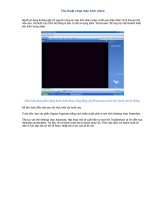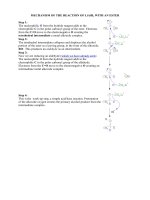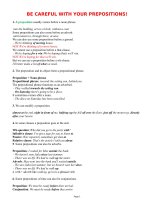biosafety levels with video guideline
Bạn đang xem bản rút gọn của tài liệu. Xem và tải ngay bản đầy đủ của tài liệu tại đây (824.14 KB, 36 trang )
BiOSAFETY Levels
Level 1,2,3,4
History
The first prototype Class III (maximum
containment)biosafety cabinetwas fashioned in
1943 by Hubert Kaempf Jr
April 18, 1955 14 Representatives met at camp
Detrick in Frederick, Maryland.
Purpose: To share knowledge and experiences
regarding bio-safety, chemical, radiological, and
industrial safety issues that were common at the three
principal laboratories of the U.S. Army
1st Biological Safety Conference.
CDC, 1964
History
Center for Disease Control (CDC) specifies the biosafety levels for the U.S.
BSL1-BSL4
T
h
e
s
t
a
n
d
a
r
d
p
r
a
c
t
i
c
e
s
p
e
r
t
a
i
n
t
o
a
l
l
l
e
v
e
l
s
Bio-safety Level- Level of the bio-containment precautions required to isolate dangerous biological agents in an enclosed facility.
Biohazard Symbol
Charles Baldwin at
National Cancer Institute
at NIH.
Symbol to be
“memorable but
meaningless” so it could
be learned.
Blaze orange – most
visible under harsh
conditions
BioSafety Level 1
BSL 1
BIOSAFETY 1 is suitable for work involving
well-characterized agents not known to cause
disease in healthy adult humans, and of minimal
potential hazard to laboratory personnel and the
environment ( CDC 1997).
The laboratory is not necessarily
separated from the general traffic
patterns in the building
BSL 1 (cont)
Work is generally conducted on open bench tops using standard
microbiological practices.
Special containment equipment or facility designs is not required
nor generally used.
Insect and rodent pest control program should be in effect
Laboratory personnel have specific training in the procedures
conducted in the laboratory and are supervised by a scientist with
general training in microbiology.
BSL 1(cont)
The following standard special practices, safety
equipment, and facilities apply to agents
assigned to all Biosafety levels.
Standard Microbiological Practices
Access to the laboratory are limited or
restricted when experiments or work with
specimens and cultures are in progress
After handling viable materials and animals
hands must be washed after removing gloves
and before leaving the laboratory.
Standard Microbiological
Practices
Eating, drinking, smoking, handling contact lenses,
and applying cosmetics are not permitted in the work
areas where there is reasonable likelihood of
exposure to potentially infectious materials. Persons
who wear contact lenses in laboratories should also
wear goggles or a face shield. Food is stored outside
the work area in cabinets or refrigerators designated
and used for this purpose only.
Mouth pipetting is prohibited; mechanical pipetting
devices are used.
Standard Microbiological
Practices
All procedures are performed carefully to minimize the creation of
splashes or aerosols.
Work surfaces are decontaminated at least once a day and after any
spill of viable material.
All cultures, stocks, and other regulated wastes are decontaminated
before disposal by an approved decontamination method.
Materials to be decontaminated outside of the immediate laboratory
are to be placed in a durable, leak-proof container and closed for
transport from the laboratory.
Materials to be decontaminated at off-site from the laboratory are
packaged in accordance with applicable local, state, and federal
regulations, before removal from the facility.
Safety Equipment
Special containment devices or equipment such as a
biological safety cabinet are generally not required for
manipulations of agents assigned to Biosafety Level 1.
It is recommended that laboratory coats, gowns, or uniforms
be worn to prevent contamination or soiling of street clothes.
Gloves should be worn if the skin on the hands is broken or if
a rash exists.
Safety Equipment
Protective eyewear should be worn for anticipated splashes
of microorganisms or other hazardous materials to the face.
Laboratory Facilities
Each laboratory contains a sink for hand washing.
The laboratory is designed so that it can be easily
cleaned. Rugs in laboratories are not appropriate, and
should not be used because proper decontamination
following a spill extremely difficult to achieve.
Bench tops are impervious to water and resistant to
acids, alkalis, organic solvents, and moderate heat.
Laboratory Facilities
(cont)
Laboratory furniture is sturdy. Spaces
between benches, cabinets, and equipment
are accessible for cleaning.
If the laboratory has windows that open,
they are fitted with fly screens.
BioSAFETY Level 2
BIOSAFETY CONTAINMENT LEVEL 2
Risk Group 2 infectious agents are pathogens
that can cause human or animal disease but,
under normal circumstances, are unlikely to be
a serious hazard to laboratory workers, the
community, livestock, or the environment
Level 2 infections are not considered to be a
serious hazard. They are a moderate individual
risk and limited community risk.
BIOSAFETY CONTAINMENT
LEVEL 2
Laboratory exposures rarely cause infection leading
to serious disease; effective treatment and preventive
measures are available and the risk of spread is
limited.
Examples of infectious agents in this risk level are
E. coli, California encephalitis viruses, many
influenza viruses, some fungi like ringworm;
California encephalitis viruses; human herpes
simplex viruses; many influenza viruses;
Transmissible Gastro-enteritis of swine; Mouse
Hepatitis Virus; and a few parasites.
PROCEDURES REQUIRED TO
CONTAIN RISKGROUP 2 ORGANISMS
The laboratory should be separated from all other
activities.
A biohazard sign should be present and visible.
All the surfaces in the laboratory should be readily
cleanable and impervious.
An auto clave should be present.
A certified HEPA filtered class 1 or 2 biological cabinet
should be available for the manipulation of organisms.
Gloves and a laboratory coat should be worn at all times
in the laboratory.
BioSafety Level 3
BIOSAFETY CONTAINMENT LEVEL
3
Risk Group 3 infectious agents are pathogens that
usually cause serious human or animal disease, or
which can result in serious economic consequences, but
do not ordinarily spread by casual contact from one
individual to another (high individual risk, low community
risk), or that can be treated by antimicrobial or
antiparasitic agents.
Risk Group 3 pathogens include bacteria such as
anthrax, Q Fever, tuberculosis, and viruses such as
hanta viruses, Human immunodeficiency viruses (HIV -
all isolates), eastern and western equine encephalitis
viruses.
PROCEDURES REQUIRED TO
CONTAIN RISKGROUP 3 ORGANISMS
Laboratory staff must be fully trained in the handling of
pathogenic and other hazardous material, in the use of
safety equipment, disposal techniques, handling of
contaminated waste, and emergency response.
Standard operating procedures must be pasted in
visible spot.
Equipment must include an autoclave and a certified
HEPA filtered class II biological safety cabinet
All activities involving infectious materials to be
conducted in biological safety cabinets or other
appropriate combinations of personal protective and
physical containment devices.
PROCEDURES REQUIRED TO
CONTAIN RISKGROUP 3
ORGANISMS
Personal protective equipment should include
head covers and dedicated footwear, gloves,
appropriate respiratory protection
Specialized design and construction of
laboratories, with controlled access double door
entry and body shower.
Air pressure must be negative at all times, no
recirculation, HEPA filtration must be used.
BioSafety Level 4
The
Galveston Natio
nal Laboratory
BSL-4 (P4) lab
on the Campus
of theUniversity
of Texas Medic
al Branch
BSL- 4
Designed for use with:
Highly toxic/infectious agents
Agents that are at a very high risk for forming infectious aerosols
Life threatening agents
Ex. Ebola, Marburg, Lassa
Special Practices
Only those that work in the BSL-4 lab will be allowed entry
Immuno-compromised individuals such as children and pregnant
women are not allowed to enter
A logbook must be signed each time one comes in or out of the lab
with the date and time









